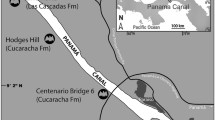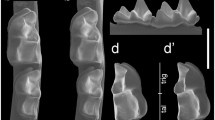Abstract
A new genus and species of emballonurid microchiropteran,Tachypteron franzeni, is described from the early Middle Eocene (MP 11) of Grube Messel, near Darmstadt, Germany. The holotype is extraordinarily well-preserved. It is the first unequivocal representative of an extant clade among Messel bats and the oldest unequivocal record of Emballonuridae. The flight apparatus ofT. franzeni is highly specialized for a rapid and constant flight style. The proportions of the strikingly narrow wing, the outline of the flight membranes and external ear, the morphology of the postcranial skeleton, and the relative cochlea size ofT. franzeni and extantTaphozous species are almost identical, while the dentition ofT. franzeni is distinguished by more plesiomorphic features.Tachypteron and the fairly diverse Paleogene record of emballonurids from France, consisting mainly of isolated teeth, document the earliest radiation known from an extant bat family and suggest a rather intense pre-Middle Eocene diversification of emballonurids.
Kurzfassung
Es wird eine neue Gattung und Art der Microchiropteren-Familie Emballonuridae,Tachypteron franzeni, aus dem unteren Mittel-Eozän (MP 11) der Grube Messel bei Darmstadt, Hessen, beschrieben. Der Holotypus ist außergewöhnlich gut erhalten.T. franzeni ist der erste unzweideutige Angehörige einer modernen Familie in der Messeler Fledermausfauna und zugleich der älteste unzweideutige Nachweis der Familie Emballonuridae. Der Flugapparat vonT. franzeni ist extrem spezialisiert für einen schnellen und stetigen Flug. Die Proportionen des auffallend schmalen Flügels, der Umriss der Flughäute und des äußeren Ohrs, die Morphologie des post-kranialen Skeletts sowie die relative Cochlea-Größe vonT. franzeni und rezenten Arten der GattungTaphozous sind nahezu identisch. Dagegen unterscheidet sichT. franzeni durch einige plesiomorphe Gebißmerkmale.T. franzeni und die recht vielgestaltigen Nachweise paläogener Emballonuriden aus Frankreich, meistens Einzelzähne, belegen die früheste von einer rezenten Fledermausfamilie bekannte Radiation und weisen auf ziemlich intensive evolutive Prozesse der Emballonuriden vor dern Mittel-Eozän hin.
Similar content being viewed by others
Literature
Astruc, J.G.;Escarguel, G.;Marandat, B.;Simon-Coinçon, R. &Sigé, B. 2000. Floor-age constraining of a tectonic paroxysm of the Pyrenean orogen. Late Middle Eocene mammal age of a faulted karstic filling of the Quercy phosphorites, south-western France. — Geodinamica Acta13: 271–280.
Barghoorn, S.F. 1977. New material ofVespertiliavus Schlosser (Mammalia, Chiroptera) and suggested relationships of emballonurid bats based on cranial morphology. — American Museum Novitates2818: 1–29.
Blumenbach, J.F. 1779. Handbuch der Naturgeschichte. 1. Theil. — 448 p., Göttingen (J. Ch. Dieterich).
Butler, P.M. 1984. Macroscelidea, Insectivora and Chiroptera from the Miocene of East Africa. — Palaeovertebrata14 (3): 117–200.
Cooper, C.F. 1932. On some mammalian remains from the Lower Eocene of the London Clay. — The Annals and Magazine of Natural History (10)9: 458–467.
Dobson, G.E. 1875. Conspectus of the suborders, families, and genera of Chiroptera arranged according to their natural affinities. — The Annals and Magazine of Natural History (4)16: 345–357.
Gervais, P. 1855. Mammifères. — In:de Castelnau, F. Comte, Expédition dans les parties centrales de l’Amérique du sud, de Rio de Janeiro à Lima, et de Lima au Para; exécutée pendant les années 1843 à 1847, sous la direction duComte Francis (L.De Laporte Comte)De Castelnau, (7) Zoologie (1–2). — 116 p., Paris (Bertrand).
Habersetzer, J. &Storch, G. 1987. Klassifikation und funktionelle Flügelmorphologie paläogener Fledermäuse. — Courier Forschungsinstitut Senckenberg91: 117–150.
Habersetzer, J. &Storch, G. 1989. Ecology and echolocation of the Eocene Messel bats. — In:Hanák, V.;Horácek, I. &Gaisler, J., eds., European bat research 1987: 213–233, Praha (Charles University Press Praha).
Habersetzer, J. &Storch, G. 1992. Cochlea size in extant Chiroptera and middle Eocene microchiropterans from Messel. — Naturwissenschaften79: 462–466.
Hill, J.E. &Smith, J.D., 1984. Bats. A natural history. — 243 p., London (British Museum [Natural History]).
Hooker, J.J. 1996. A primitive emballonurid bat (Chiroptera, Mammalia) from the earliest Eocene of England. — Palaeovertebrata25: 287–300.
Legendre, S. 1980. Un chiroptère emballonuridé dans le Néogène d’Europe Occidentale; considérations paléobiogéographiques. — Geobios13 (6): 839–847.
Marandat, B.;Crochet, J.-Y.;Godinot, M.;Hartenberger, J.-L.;Legendre, S.;Remy, J. A.;Sigé, B.;Sudre, J. &Vianey-Liaud, M. 1993. Une nouvelle faune à mammifères d’âge Éocène moyen (Lutétien supérieur) dans les Phosphorites du Quercy. — Geobios26: 617–623.
Miller, G.S. 1907. The families and genera of bats. — Bulletin of the United States National Museum57: 1–282.
Morlo, M. &Habersetzer, J. 1999. The Hyaenodontidae (Creodonta, Mammalia) from the lower Middle Eocene (MP 11) of Messel (Germany) with special remarks on new x-ray methods. — Courier Forschungsinstitut Senckenberg216: 31–73.
Norberg, U. &Rayner, J.M.V. 1987. Ecological morphology and flight in bats (Mammalia; Chiroptera): wing adaptations, flight performance, foraging strategy and echolocation. — Philosophical Transactions of the Royal Society London (B)316: 335–427.
Remy, J.A.;Aguilar, J.-P.;Crochet, J.-Y.;Duffaud, S.;Escarguel, G.;Godinot, M.;Marandat, B.;Michaux, J.;Rage, J.-C.;Sigé, B. &Wiénin, M. 1997. Les remplissages karstiques polyphasés (Eocène, Oligocène, Pliocène) de Saint-Maximin (phosphorites du Gard) et leur apport à la connaissance des faunes européennes, notamment pour l’Eocène moyen (MP 13). 1. Introduction, Systématique (pars) et Synthèse. — In:Aguilar, J.-P.;Legendre, S. &Michaux, J., eds., Actes du Congrès BiochroM’97. — Mémoires et Travaux de l’Institut de Montpellier de l’école Pratique des Hautes Études21: 711–728.
Revilliod, P. 1920. Contribution a l’étude des chiroptères des terrains tertiaires. Deuxième partie. — Mémoires de la Société Paléontologique Suisse44: 63–128.
Russell, D.E. 1964. Les mammifères paléocènes d’Europe. — Mémoires du Muséum National d’Histoire Naturelle (N.Sér.) (C)13: 1–324.
Schlosser, M. 1887. Die Affen, Lemuren, Chiropteren, Insectivoren, Marsupialier, Creodonten und Carnivoren des europäischen Tertiärs und deren Beziehungen zu ihren lebenden und fossilen aussereuropäischen Verwandten. — Beiträge zur Paläontologie Österreich-Ungarns und des Orients6 (1–2): 1–224.
Sigé, B. 1988. Le gisement du Bretou (Phosphorites du Quercy, Tarn-et-Garonne, France) et sa faune de vertébrés de l’Eocène supérieur. IV. Insectivores et chiroptères. — Palaeontographica (A)205: 69–102.
Sigé, B. 1995. Le Garouillas et les sites contemporains (Oligocène, MP25) des phosphorites du Quercy (Lot, Tanret-Garonne, France) et leurs faunes de vertébrés. 5. Chiroptères. — Palaeontographica (A)236: 77–124.
Sigé, B. 1997. Les remplissages karstiques polyphasés (Éocène, Oligocène, Pliocène) de Saint-Maximin (Phosphorites du Gard) et leur apport à la connaissance des faunes européennes, notamment pour l’Éocène moyen (MP 13). 3. Systématique: Euthériens entomophages. — In:Aguilar, J.-P.;Legendre, S. &Michaux, J., eds., Actes du Congrès BiochroM’97. — Mémoires et Travaux de l’Institut de Montpellier de l’École Pratique des Hautes Études21: 737–750.
Sigé, B.;Thomas, H.;Sen, S.;Gheerbrant, E.;Roger, J. &Al-Sulaimani, Z. 1994. Les chiroptères de Taqah (Oligocène inférieur, Sultanat d’Oman). Premier inventaire systématique. — Münchner Geowissenschaftliche Abhandlungen (A)26: 35–48.
Simmons, N.B. &Geisler, J.H. 1998. Phylogenetic relationships ofIcaronycteris, Archaeonycteris, Hassianycteris, andPalaeochiropteryx to extant bat lineages, with comments on the evolution of echolocation and foraging strategies in Microchiroptera. — Bulletin of the American Museum of Natural History235: 1–182.
Sudre, J.;Sigé, B.;Remy, J.A.;Marandat, B.;Hartenberger, J.-L.;Godinot, M. &Crochet, J.-Y. 1990. Une faune de niveau d’Egerkingen (MP 14; Bartonien inférieur) dans les Phosphorites du Quercy (Sud de la France). — Palaeovertebrata20: 1–32.
Wassif, K. &Madkour, G. 1972. The structure of the os penis in Egyptian bats (Micochiroptera). — Bulletin of the Zoological Society of Egypt24: 45–51.
Weithofer, A. 1888. Zur Kenntniss der fossilen Cheiropteren der französischen Phosphorite. — Sitzungsberichte der Kaiserlichen Akademie der Wissenschaften. Mathematisch-Naturwissenschaftliche Classe96 (1. Abt.): 341–360.
Winge, H. 1941. The interrelationships of mammalian genera. Vol. 1: Monotremata, Marsupialia, Insectivora, Chiroptera, Edentata. — 418 p., Copenhagen (C.A. Reitzels). [English translation byDeichmann, E. &Allen, G.M. ofWinge, H. 1923, Pattedyr-Slaegter, 1].
Author information
Authors and Affiliations
Rights and permissions
About this article
Cite this article
Storch, G., Sigé, B. & Habersetzer, J. Tachypteron franzeni n. gen., n. sp., earliest emballonurid bat from the Middle Eocene of Messel (Mammalia, Chiroptera). Paläontol Z 76, 189–199 (2002). https://doi.org/10.1007/BF02989856
Received:
Accepted:
Issue Date:
DOI: https://doi.org/10.1007/BF02989856




